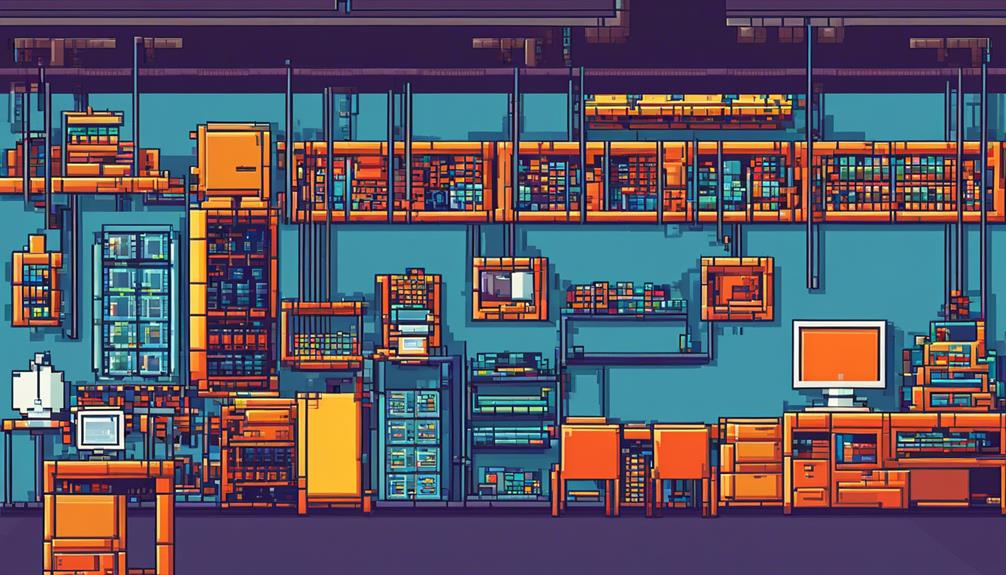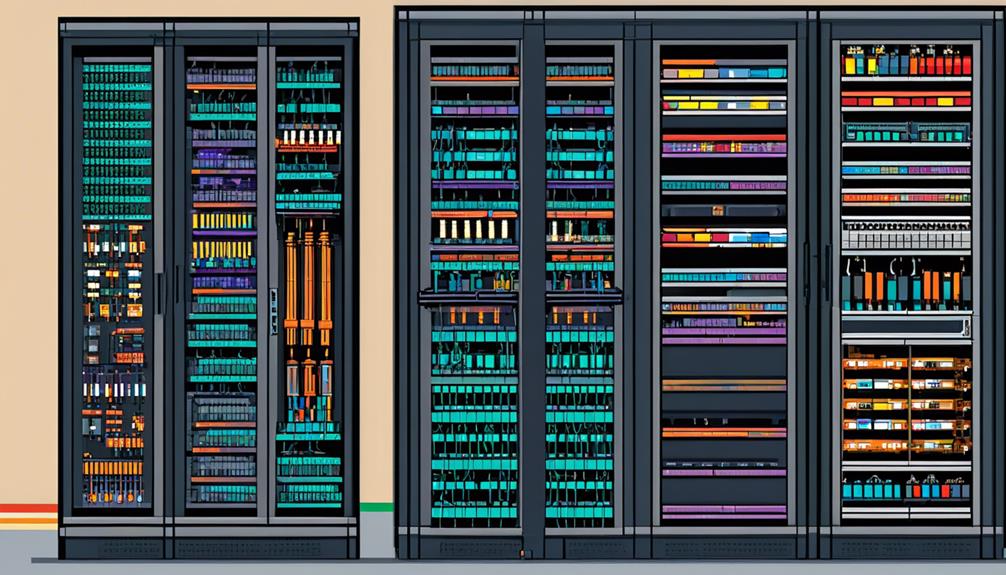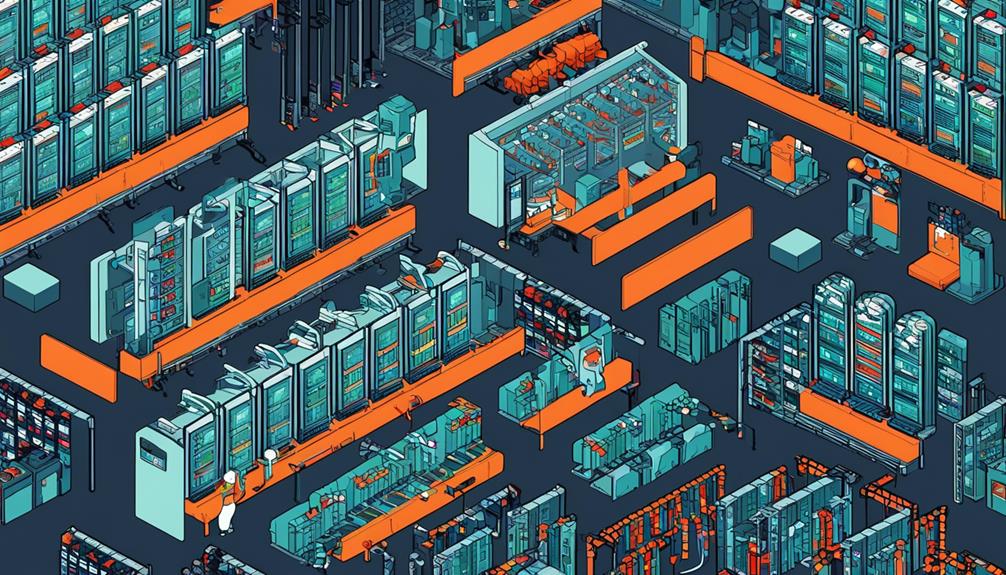Efficient and organized cable management solutions are a crucial aspect of the telecom industry. With the continuous expansion of networks and the increasing complexity of cabling systems, it becomes imperative to have a structured approach to manage cables.
Whether it is organizing cables within server racks, patch cabinets, or data networking cabinets, the use of rack mountable cable management solutions, cable management panels, and rings, among others, is essential. These solutions not only improve the overall appearance of the setup but also provide a centralized and organized solution for network connections.
However, the real challenge lies in finding the most suitable cable management solution that meets specific requirements and ensures long-term manageability.
Key Takeaways
- Cable management solutions in telecom include cable tray systems, underfloor cable management, vertical cable management, and the importance of cable routing and labeling.
- Proper installation and maintenance of cable management solutions is crucial for efficient cable organization.
- Power cable management techniques such as cable routing and labeling systems offer benefits in conduits.
- Cable management solutions in data centers, including Molex's rack systems, improve aesthetics and functionality in rack setups.
Cable Tray Systems

Cable tray systems are a cost-effective and efficient solution for managing and supporting large quantities of cables in telecom setups. These systems provide a secure and organized pathway for cables, ensuring easy access for maintenance and troubleshooting. Cable tray systems come in various materials and designs to accommodate different installation requirements and environments. They play a crucial role in preventing cable damage, reducing clutter, and optimizing airflow in telecom infrastructures.
One of the key advantages of cable tray systems is their versatility. They can be installed in various settings, including data centers, telecom rooms, and equipment racks. This flexibility allows for seamless integration into different telecom setups, regardless of their size or complexity.
In terms of design, cable tray systems are available in different types, such as ladder, solid-bottom, and wire mesh. Ladder trays are commonly used when heavy-duty support is required, while solid-bottom trays provide additional protection for sensitive cables. Wire mesh trays, on the other hand, offer excellent ventilation and are ideal for managing high-density cable installations.
The choice of material for cable tray systems depends on the specific requirements of the telecom setup. Steel, aluminum, and fiberglass are some of the commonly used materials. Steel trays offer high strength and durability, making them suitable for heavy-duty applications. Aluminum trays are lightweight and corrosion-resistant, making them ideal for outdoor installations. Fiberglass trays are non-conductive and provide excellent resistance to chemicals and moisture.
Underfloor Cable Management
Underfloor cable management offers numerous benefits such as optimized space utilization, easy cable control, and improved organization in telecom setups.
The installation process typically involves planning, routing, and securing cables in an underfloor system that meets the requirements of the specific environment.
To ensure efficient maintenance, regular inspection and cleaning of the underfloor cable management system are recommended to prevent cable damage and ensure uninterrupted connectivity.
Benefits of Underfloor Management
The utilization of underfloor cable management in telecom environments offers numerous benefits for optimizing space utilization, ensuring workplace safety, enabling efficient maintenance, and enhancing network performance and reliability.
- Optimal Space Utilization:
- Concealing cables beneath the floor creates a cleaner and organized appearance, freeing up overhead space for other purposes.
- Workplace Safety:
- Routing cables under the floor reduces tripping hazards and minimizes cable damage, enhancing workplace safety and prolonging the lifespan of the cabling infrastructure.
- Efficient Maintenance:
- Underfloor cable management allows for easier maintenance and reconfiguration of cabling systems, enabling quick adjustments without disrupting the workspace.
- Enhanced Network Performance and Reliability:
- By minimizing electromagnetic interference and signal degradation, underfloor cable management ensures better performance and reliability of network connections.
These benefits make underfloor cable management a valuable solution for telecom environments, optimizing space, ensuring safety, enabling efficient maintenance, and enhancing network performance and reliability.
Installation Process and Requirements
The installation process for underfloor cable management in telecom environments requires careful planning and coordination with other building services, ensuring a smooth and efficient implementation of the system.
Prior to installation, it is crucial to clear the underfloor space of any obstructions and prepare it for the installation of the cable management system. This may involve the use of suitable floor boxes, access panels, and cable trays to accommodate the cabling infrastructure.
It is essential to adhere to industry standards and building codes for safety and performance during the installation process. Additionally, proper documentation and labeling of the installed underfloor cable management system are crucial for future maintenance and troubleshooting.
Following these requirements and guidelines will ensure an effective and reliable cable management system in telecom environments.
Maintenance Tips and Tricks
After completing the careful installation process and ensuring compliance with industry standards and building codes, it is essential to implement effective maintenance tips and tricks for underfloor cable management in telecom environments. Here are some crucial maintenance tips and tricks to consider:
- Regularly inspect and clean underfloor cable pathways to prevent debris and dust buildup.
- Use cable ties and labels to organize and secure cables under the raised floor, facilitating easier maintenance and troubleshooting.
- Implement cable management accessories such as cable trays and baskets to maintain proper separation and organization of cables.
- Utilize cable guards and protectors to shield cables from potential damage caused by foot traffic or equipment movement.
- Conduct periodic cable audits and reorganization to optimize cable routing and ensure efficient maintenance access.
Vertical Cable Management
Vertical cable management solutions are essential for efficiently organizing and routing cables along the height of server racks and cabinets in a systematic and organized manner. These solutions are specifically designed to manage large numbers of cables in a confined space, ensuring a clean and organized appearance. By routing cables vertically, these solutions help improve airflow and accessibility within the rack or cabinet.
One of the key advantages of vertical cable management is its ability to handle a large volume of cables. With the increasing complexity of telecom networks, the number of cables running through server racks and cabinets has also significantly increased. Vertical cable management solutions provide a systematic and efficient approach to managing and maintaining these cables. By organizing them in a vertical direction, these solutions optimize space utilization, making it easier to identify and access specific cables when needed.
In addition to efficient space utilization, vertical cable management solutions also enhance cable management by reducing cable strain and preventing tangling. By neatly routing cables along the height of the rack or cabinet, these solutions minimize the risk of cable damage and ensure the longevity of the network infrastructure. Moreover, they contribute to a safer working environment by reducing tripping hazards and facilitating easier cable tracing and troubleshooting.
To summarize, vertical cable management solutions are an indispensable aspect of telecom infrastructure. By efficiently organizing and routing cables along the height of server racks and cabinets, these solutions optimize space utilization, enhance airflow, and simplify cable management. With the ever-increasing complexity of telecom networks, implementing effective vertical cable management solutions is crucial for maintaining a clean and organized network infrastructure.
Cable Routing and Labeling

Cable routing and labeling play a crucial role in ensuring the organized and efficient management of cables within telecom infrastructure. Proper cable labeling helps in easy identification and troubleshooting of network connections. By clearly marking cables with relevant information, such as their purpose, destination, and origin, network administrators can quickly identify and rectify any issues that may arise. This not only saves time but also minimizes the chances of accidental disconnections, reducing downtime and improving productivity.
Effective cable routing is equally important. By carefully planning and implementing cable pathways, the risk of cable damage is reduced. Cables can be routed away from potential hazards such as sharp edges or areas with high foot traffic, ensuring their longevity and reliability. Furthermore, well-organized cable routing optimizes the overall appearance of the networking infrastructure, presenting a neat and professional impression to clients and visitors.
Clear cable labeling also facilitates quick and accurate maintenance and upgrades within the telecom setup. When cables are appropriately labeled, technicians can easily identify and replace faulty or outdated components, minimizing disruption to the network and ensuring smooth operations. Additionally, during network upgrades or expansions, labeled cables allow for efficient identification of specific connections, streamlining the installation process.
Cable Management Accessories
When it comes to cable management accessories, there are various types available to cater to different needs. These accessories play a crucial role in maintaining organization and tidiness in telecom setups.
In this discussion, we will explore the different types of accessories, highlight the importance of organization, and provide installation tips for effective cable management.
Types of Accessories
To effectively manage cables in telecom systems, a wide range of accessories are available to ensure optimal organization and functionality. These accessories play a crucial role in maintaining cable integrity, preventing damage, and facilitating easy maintenance.
Some of the popular types of cable management accessories include:
- Cable Manager 2U Front/Rear: These accessories provide a neat and organized solution for managing cables in telecom racks. They feature a 2U design, allowing for efficient utilization of rack space. The front/rear configuration enables easy access to cables from both sides, simplifying installation and maintenance tasks.
Importance of Organization
Proper organization is essential when it comes to cable management accessories. They contribute to the overall efficiency and functionality of the telecom system. Cable management accessories play a crucial role in controlling and organizing cables with minimal effort, ensuring that the wiring closet remains manageable.
This organization makes it easier to maintain and troubleshoot connectivity issues, reducing downtime and improving the overall performance of the network. Moreover, cable management accessories such as panels, rings, and bars help in keeping server racks and patch cabinets tidy and manageable, improving the aesthetic and functionality of the setup.
By implementing these solutions, cables are properly organized, leading to a neater and more efficient network setup. Additionally, rack-mountable cable management solutions not only enhance the appearance of the setup but also support the efficient and secure storage of IT equipment and network cables.
The importance of organization cannot be overstated when it comes to cable management accessories, as it directly impacts the effectiveness and reliability of the telecom system.
Installation Tips
Cable management accessories offer efficient solutions for organizing and managing cables within the telecom infrastructure. When installing these accessories, it is important to ensure that they are rack mountable, allowing for easy integration into server racks and patch cabinets.
To keep server racks and patch cabinets tidy, cable management panels and rings can be utilized, simplifying cable management efforts. Additionally, it is recommended to use data networking cabinets specifically designed for data centers and telecom rooms to ensure proper organization and management of network cables.
Zone enclosures can also be incorporated to support the convergence of data and voice networks, providing a centralized and organized solution for network connections. Wire harness brackets, horizontal cable management, and cable routing blanks are also effective tools for managing and organizing cables within the telecom infrastructure.
Cable Management Software
What role does cable management software play in controlling and organizing cables within a network or infrastructure?
Cable management software is a crucial tool that aids in the efficient control and organization of cables within a network or infrastructure. It provides a centralized platform that allows network administrators to track, monitor, and manage cable connections effectively. By streamlining the process of documenting and visualizing cable layouts and connections, cable management software simplifies the management of complex cable infrastructures.
One of the key advantages of cable management software is its ability to assist in identifying and troubleshooting cable-related issues. By providing real-time information about cable connections and their status, network administrators can quickly locate and resolve any connectivity problems. This helps in minimizing downtime and improving the overall performance of the network.
Moreover, cable management software plays a vital role in facilitating efficient maintenance and upgrades. It provides detailed cable mapping and documentation, which is essential during maintenance activities such as adding or removing cables. This accurate documentation ensures that cables are correctly connected, reducing the risk of errors or misconfigurations.
In addition to these benefits, cable management software also enables better resource planning by providing insights into cable utilization and capacity. This helps network administrators optimize cable usage and plan for future expansions or upgrades.
Fiber Optic Cable Management

Fiber optic cable management is essential for maintaining the integrity and functionality of high-speed data transmission systems. Proper fiber optic cable management ensures minimal signal loss and prevents damage to delicate fiber strands.
To achieve effective fiber optic cable management, there are several solutions available:
- Rack mountable enclosures: These provide a centralized location for organizing and protecting fiber optic cables. They are designed to securely hold and route cables, minimizing the risk of accidental damage or disconnection. Rack mountable enclosures also offer easy access for maintenance and troubleshooting.
- Panels: Fiber optic cable management panels are used to securely hold and organize fiber optic cables. They typically feature a design that allows for easy cable routing and identification. Panels also provide protection against dust, moisture, and other environmental factors that can potentially degrade the performance of fiber optic cables.
- Rings: Fiber optic cable management rings are used to organize and support cables within racks or cabinets. They help maintain proper bend radius and prevent cable tangling, which can cause signal loss or disruption. Rings also make it easier to trace and identify specific cables, facilitating faster installation and maintenance.
When it comes to fiber optic cable management, attention to detail and proper handling are crucial. Any mishandling or improper routing of fiber optic cables can compromise data integrity and result in significant signal loss.
It is therefore imperative to utilize appropriate fiber optic cable management solutions that provide secure and organized routing, storage, and protection within telecom and data center environments. By implementing these solutions, organizations can ensure the smooth and efficient operation of their high-speed data transmission systems.
Power Cable Management
When it comes to power cable management, two key aspects to consider are cable routing techniques and cable labeling systems.
Proper cable routing techniques involve organizing and routing power cables in a way that minimizes clutter and ensures efficient power distribution.
Cable labeling systems, on the other hand, provide a systematic way to identify and track power cables, making it easier to troubleshoot and maintain the power infrastructure.
These two points are crucial for effective power cable management in telecom environments.
Cable Routing Techniques
To optimize power cable management, various cable routing techniques can be implemented using rack mountable cable management solutions, cable management panels, rings, and specialized network cabinets. These techniques ensure the long-term manageability of the wiring closet and control cables with minimal effort.
Consider utilizing cable management panels and rings as they are ideal solutions for keeping server racks and patch cabinets tidy, making cable management easier, and improving the overall appearance of the setup.
Molex Network Cabinets are designed specifically for data centers and telecom rooms, providing an ideal storage solution for IT equipment and high-density network cables. Additionally, Zone Enclosures support the convergence of data and voice networks, providing a centralized and organized solution for network connections, especially for PoE devices.
Explore cable routing techniques such as Motive Cable Managers, Evolution Cable Management System, and Velocity Cable Management, each offering unique features and options to optimize cable management.
One popular technique is using a horizontal cable manager, which facilitates the routing and organization of cables within a rack, ensuring proper airflow and easy access for maintenance.
Cable Labeling Systems
Cable labeling systems play a crucial role in efficiently managing and organizing power cables within telecom setups. These systems provide a systematic approach for identifying and maintaining power cables, ensuring easy troubleshooting and maintenance. By reducing the risk of accidental disconnection or damage to power cables, cable labeling systems contribute to a safer and more efficient working environment. Designed to withstand the rigors of telecom environments, these systems offer durable and long-lasting identification solutions. They also aid in compliance with industry standards and regulations by ensuring proper documentation and traceability of power cables within the network. The following table highlights some key features and benefits of cable labeling systems:
| Features | Benefits |
|---|---|
| Easy identification | Efficient troubleshooting |
| Accurate documentation | Compliance with industry standards |
| Durable and long-lasting | Reduced risk of accidental disconnection |
| Enhanced organization | Safer working environment |
| Improved maintenance | Increased efficiency |
Cable labeling systems are an essential component of power cable management, helping telecom setups to maintain an organized and reliable infrastructure.
Cable Management in Data Centers

Efficient cable management is crucial in data centers to ensure the organization and proper functioning of server racks and patch cabinets. To achieve this, various cable management solutions are employed:
- Rack mountable cable management solutions: These solutions are designed specifically for server racks and patch cabinets. They provide a systematic approach to organizing and managing cables, ensuring easy access and troubleshooting when required.
- Cable management panels and rings: These components help control cables with minimal effort. By neatly routing and securing cables, they ensure the long-term manageability of the wiring closet. Cable management panels and rings come in various sizes and configurations to accommodate different cable types and quantities.
- Data networking cabinets: These cabinets are engineered to house IT equipment and high-density network cables. They provide a secure and efficient storage solution, ensuring the cables are protected from damage and unauthorized access. Additionally, data networking cabinets are designed with cable management features, such as cable trays and channels, to facilitate proper cable routing and organization.
In data centers, flexibility for front cable is a key consideration. UTP (Unshielded Twisted Pair) and optical fiber cables are commonly used for network connectivity. UTP cables are typically used for Ethernet connections, while optical fiber cables offer high-speed and long-distance transmission capabilities. The cable management solutions in data centers should accommodate both types of cables and provide the flexibility required for efficient cable routing and organization at the front end of the equipment.
Cable Management in Outdoor Environments
In outdoor environments, the management of cables requires rugged and weatherproof solutions that can withstand exposure to weather elements and temperature variations, ensuring the protection and organization of cables. Cable management in outdoor environments necessitates the use of specialized products that prioritize durability and functionality in challenging conditions.
When it comes to outdoor cable management, flexibility for front cables is a crucial consideration. The ability to easily access and manipulate cables at the front end is essential for installation, maintenance, and repairs. This flexibility ensures efficient and effective cable management, reducing downtime and improving overall network performance.
To meet the demands of outdoor environments, cable management solutions must be designed with UV resistance and corrosion protection in mind. Ultraviolet (UV) rays from the sun can cause degradation and discoloration of cables and management components over time. Corrosion, on the other hand, can occur due to exposure to moisture, rain, and other environmental factors. Therefore, utilizing weatherproof and corrosion-resistant materials is critical for long-term functionality.
Outdoor cable management involves securing and organizing various cable types, including fiber optic, coaxial, and power cables. These cables may have different sizes, shapes, and connectors, which require versatile management solutions. Cable trays, cable ties, and cable clamps are commonly used to secure and route cables, ensuring they are organized and protected from potential damage caused by environmental factors.
Moreover, deployment of outdoor cable management solutions should consider factors such as wind load, rain protection, and resistance to environmental wear and tear. Properly designed and installed cable management systems can withstand high wind speeds, heavy rainfall, and extreme temperatures, ensuring the integrity and longevity of the cables.
Cable Management in Conduits

Conduits serve as an essential component for the effective and organized management of cables in various installations. They provide a neat and organized route for cables, ensuring efficient cable management.
Here are some key benefits of cable management in conduits:
- Protection: Conduits protect cables from damage caused by external factors such as moisture, dust, and physical impact. This safeguarding helps to extend the lifespan of the cables and ensures their optimal performance.
- Minimized Tangling: Cable management in conduits reduces the risk of cable tangling. By providing a dedicated pathway for each cable, conduits prevent cables from getting entangled with each other, which can lead to signal interference and operational issues.
- Easy Maintenance: Utilizing conduits makes cable maintenance and troubleshooting easier. With cables neatly organized within conduits, it becomes simpler to identify and access specific cables when making repairs or modifications. This streamlined process minimizes downtime and improves overall maintenance efficiency.
Moreover, cable management in conduits offers a professional and tidy appearance for cable installations. The cables are concealed within the conduits, creating a clean and organized aesthetic. This is particularly important in environments where visual appeal is a priority, such as offices, retail spaces, and public areas.
Cable Management in Rack Systems
Molex offers comprehensive cable management solutions specifically designed for rack systems, ensuring efficient organization and optimal functionality. Their rack mountable cable management solutions are designed to combine aesthetics with functionality, providing an organized and tidy solution for wiring closets.
Molex's cable management panels and rings are specifically designed for server racks and patch cabinets, offering a neat and organized solution for managing network cables.
To further enhance cable management in rack systems, Molex provides network cabinets designed for data centers and telecom rooms. These cabinets ensure proper organization and management of network cables, reducing the risk of cable tangling and improving overall system efficiency. Molex's Zone Enclosures are another excellent option for cable management in rack systems. These enclosures support the convergence of data and voice networks by providing a centralized and organized solution for network connections.
In addition to cabinets and enclosures, Molex offers various cable management products to ensure neat and tidy organization of cables in rack systems. Horizontal cable managers and loom tubing are available to provide effective cable routing and protection. These products help to maintain a clean and clutter-free environment, making it easier to identify and manage network cables.
Molex's cable management solutions for rack systems not only improve the overall aesthetic of the rack, but also enhance the functionality and efficiency of the system. By providing organized and properly managed cables, Molex ensures that the rack system operates smoothly and effectively, reducing the risk of downtime and improving overall network performance.
Frequently Asked Questions
What Is Cable Management Solutions?
Cable management solutions refer to techniques and tools used to organize and control the cables in a neat and efficient manner. These solutions are designed to ensure that cables are properly routed, secured, and labeled, minimizing the risk of damage or tangling.
They help maintain a clean and organized workspace, making it easier to troubleshoot and maintain the network infrastructure. Various methods and products, such as cable trays, racks, ties, and labels, are used to achieve effective cable management.
What Is the Most Common Cable Management Solution?
When it comes to cable organization, there are various solutions available in the market.
One of the most common cable management solutions is the use of cable management panels and rings. These panels and rings are designed to keep server racks and patch cabinets tidy, ensuring the organization of cables and improving the overall appearance of the setup.
They provide a simple and effective way to manage and route cables, minimizing the risk of damage and making maintenance easier.
How Do You Manage Network Cables?
Cable organization is essential for managing network cables effectively. It involves various practices such as labeling cables, using cable management solutions like racks, panels, and rings, and implementing proper cable routing techniques.
How Do You Manage Cable Effectively?
To manage cables effectively, it is essential to establish a structured approach. This involves implementing proper labeling, color coding, and documentation practices to easily identify and trace cables.
Utilizing cable management solutions such as cable trays, cable ties, and cable wraps can help organize and secure cables.
Additionally, wireless alternatives like Wi-Fi and Bluetooth can reduce the reliance on physical cables, simplifying cable management processes.
Employing these strategies ensures efficient cable management and minimizes the risk of cable damage or disconnection.
